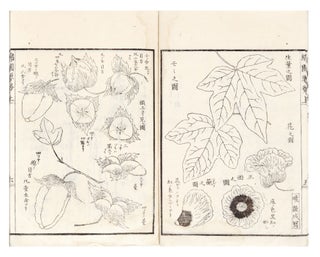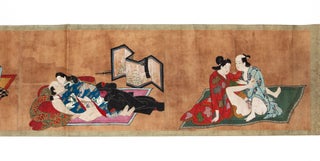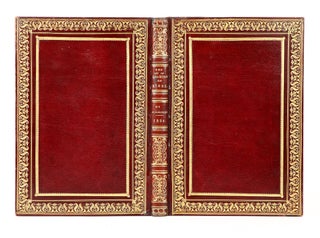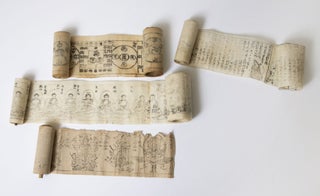Privately Printed Using Movable Type
[Seiko] Kaikoku heidan [Military Defense of a Maritime Nation].
Many woodcut illus., some full-page & double-page. Ten columns per page; 20 characters per column. Eight vols. 8vo, orig. blue (now partly faded to pale green) patterned wrappers, orig. block-printed title labels on upper covers, new stitching. Japan: Prefaces dated 1786; title-page with the date “1854.”
A privately printed edition of this famous text and an extremely rare example of a mokkatsujiban (a movable wooden type Japanese book printed after 1653; for a fascinating discussion, see Kornicki, The Book in Japan, pp. 159-63).
Hayashi (1738-93), was a Japanese scholar and a specialist in military affairs. In 1777, he travelled to Nagasaki, where he was greatly impressed by the size and strength of the Dutch ships. While there, he also learned of the Russian intentions to advance south from Siberia into Asia. This prompted him to go to the northernmost island of Hokkaido to study the situation.
As a result of this journey, he became alarmed at the weakness of Japan’s coastal defenses and ignorance of the outside world. In 1787, Hayashi began to privately issue, in a series of 16 volumes (only 38 sets were produced), his famous and controversial Kaikoku heidan, which recommended stronger military forces and a maritime defense capability. Hayashi had money problems and took until 1791 to publish all the volumes. His series is a remarkable example of a study on modern strategy, introducing the military sciences of the West to Japan. Hayashi describes the powerful weaponry of the Western powers and openly criticizes the shogunate for its ignorance of the rest of the world and reliance upon an isolationist policy while neglecting maritime defenses.
Kaikoku heidan caused a sensation and was banned by the government in 1792, on the grounds that national security matters were being discussed without official consent. Almost all copies and the woodblocks were confiscated (apparently, only the Library of Congress copy survives, acquired in 1949). Hayashi was placed under house arrest in 1792 and died the following year. In his last years, he used the pen name “Rokumusai,” meaning “Six Losses,” enumerated as: “no parents, no wife, no children, no woodblocks, no money, and no desire to die.”
Immediately after Kaikoku heidan became a forbidden book, manuscript copies were made from Hayashi’s retained original manuscript and circulated. Hayashi and his fears were soon vindicated: in September 1792, a Russian mission arrived in Hokkaido to press Japan to commence trade. As a result, Hayashi’s controversial views continued to receive serious attention and discussion for many years.
By the early 1850s, the Japanese government had received a number of unwanted foreign missions demanding that the country end its policy of seclusion and open its doors to commerce. The interest in Hayashi’s Kaikoku heidan was revived, and in 1851 or shortly thereafter, a 10-volume edition was privately printed using movable type (11 columns per page and 21 characters per column). Demand further increased following Commodore Perry’s first visit, and another movable-type edition (our edition) was issued in 1854, now reset with 10 columns per page, 20 characters per column, and printed in eight volumes. Our edition is very rare, with no copy listed in WorldCat. In 1856, three years after Perry’s first appearance, a commercial woodblock-printed edition of Kaikoku heidan was issued.
The choice of employing movable type instead of woodblocks for our edition was deliberate: the print run was intended to be limited because of the controversial text, issued sub rosa and not for commercial distribution. Books printed in movable type were less subject to government censorship and typically did not carry a colophon (our example does not have one), which was required for commercial block-printed books (again, see Kornicki, cited above). The greater fragility of wooden type precluded running off large numbers of copies.
While some of the woodcuts depict Western cannons and equipment, most of the illustrations depict Japanese defensive techniques. These include protecting ships with bamboo girding the hull; a flying ship (based on that of Lana Terzi); catapults for throwing boulders; spears; shoes designed to slide on top of snow; pontoon bridges; Dutch-, Portuguese-, and Chinese-style swords; fortification for castles (including an example designed by Vauban); battering rams; assault ladders; treatment for horses; how to build horse stables; etc., etc. The text is also fascinating: Hayashi states that foreigners become weak when the fighting gets bloody, etc.
Fine and fresh set, preserved in a chitsu. Minor worming.
Price: $7,500.00
Item ID: 8650

![Item ID: 8650 [Seiko] Kaikoku heidan [Military Defense of a Maritime Nation]. Shihei HAYASHI.](https://jonathanahill.cdn.bibliopolis.com/pictures/8650.jpg?width=768&height=1000&fit=bounds&auto=webp&v=1671567003)
![[Seiko] Kaikoku heidan [Military Defense of a Maritime Nation].](https://jonathanahill.cdn.bibliopolis.com/pictures/8650_2.jpg?width=320&height=427&fit=bounds&auto=webp&v=1671567003)
![[Seiko] Kaikoku heidan [Military Defense of a Maritime Nation].](https://jonathanahill.cdn.bibliopolis.com/pictures/8650_3.jpg?width=320&height=427&fit=bounds&auto=webp&v=1671567003)
![[Seiko] Kaikoku heidan [Military Defense of a Maritime Nation].](https://jonathanahill.cdn.bibliopolis.com/pictures/8650_4.jpg?width=320&height=427&fit=bounds&auto=webp&v=1671567003)
![[Seiko] Kaikoku heidan [Military Defense of a Maritime Nation].](https://jonathanahill.cdn.bibliopolis.com/pictures/8650_5.jpg?width=320&height=427&fit=bounds&auto=webp&v=1671567003)
![[Seiko] Kaikoku heidan [Military Defense of a Maritime Nation].](https://jonathanahill.cdn.bibliopolis.com/pictures/8650_6.jpg?width=320&height=427&fit=bounds&auto=webp&v=1671567003)
![[Seiko] Kaikoku heidan [Military Defense of a Maritime Nation].](https://jonathanahill.cdn.bibliopolis.com/pictures/8650_7.jpg?width=320&height=427&fit=bounds&auto=webp&v=1671567003)
![[Seiko] Kaikoku heidan [Military Defense of a Maritime Nation].](https://jonathanahill.cdn.bibliopolis.com/pictures/8650_8.jpg?width=320&height=427&fit=bounds&auto=webp&v=1671567003)



